 Colin Wilson is a comic book artist connecting continents. He was born in New Zealand, lived in England an France in the 1980s and 1990s and moved to Australia in 1997. His first professional comics appeared in the British anthology 2000 AD, since then he made comic books for both sides of the anthology: He worked for Frech and Belgian publishers (The Young Blueberry, Bullet in the Head) as well as American publishers (Point Blank, Star Wars: Invasion). When New Zealand was guest of honour at the Frankfurt Book Fair in 2012, he was invited by German publisher Panini to do some signings in Germany. Stefan Svik met him at a comics store in Hanover for the following interview.
Colin Wilson is a comic book artist connecting continents. He was born in New Zealand, lived in England an France in the 1980s and 1990s and moved to Australia in 1997. His first professional comics appeared in the British anthology 2000 AD, since then he made comic books for both sides of the anthology: He worked for Frech and Belgian publishers (The Young Blueberry, Bullet in the Head) as well as American publishers (Point Blank, Star Wars: Invasion). When New Zealand was guest of honour at the Frankfurt Book Fair in 2012, he was invited by German publisher Panini to do some signings in Germany. Stefan Svik met him at a comics store in Hanover for the following interview.
[Hier geht’s zur deutschen Version!]
Colin Wilson and I are introduced, we shake hands and we start the interview with a little gift from Hanover: Herrenhäusener Pils und Bahlsen Kekse.
Comicgate: I know you prefer wine (he said so in the interview printed in the deluxe edition of Battler Britton, his homage to war comics from the 50s and 60s he made with author Garth Ennis), but we are in Nothern Germany, so I give you beer.
Colin Wilson: Thank you. I think the beer will not leave the shop (laughs).
Garth Ennis is from Northern Ireland and your are a … Kiwi … is that expression an offence?
(Laughes) No, it’s pefectly accurate.
 Is Battler Britton more about a conflict berween the Commonwealth Nations vs the USA rather than the Allies vs Germany? Do you find yourself in the story?
Is Battler Britton more about a conflict berween the Commonwealth Nations vs the USA rather than the Allies vs Germany? Do you find yourself in the story?
I find myself in the airplanes. The flying was the thing that got me interested in doing the book. The story is an homage to a Scottish artist who I grew up with, who was very good at drawing planes from Second World War. That was what got me into the story. I had no idea what Garth would take the story to.
Did you have any contact with Garth Ennis or was it only via e-mail?
Only by e-mail at first, but after the first monthly issue I have visited him in New York and spent an evening drinking Guinness with him (smiles and laughs) and socializing. It was a good chance to meet someone. Most often I work from Australia so I usually don’t meet the people I work with.
Would it be easier for your career as an artist living in the USA?
No, I don’t think so. Not these days. Once upon a time it was almost essential but it’s no longer like that with the internet. It’s a good excuse every few years to travel like this year to Germany to meet people, but e-mail makes life so much easier. It’s just fantastic.
Do you have a comics scene in New Zealand?
We do. In both New Zealand and Australia. When I first started drawing comics there wasn’t anyone else I knew that was interested in that kind of thing. And because of publishing a fanzine a long time ago I started to get to know people. Now in Melbourne, where I live at the present time, we have a fantastic little comics scene, with people self-publishing, people working for overseas. We meet once a month. It can be 35 to 40 people there in one afternoon. We usually talk everything but comics, but it’s a good chance for new people who look for work. We can encourage them. That’s going on for the last 5 to 10 years, I guess.
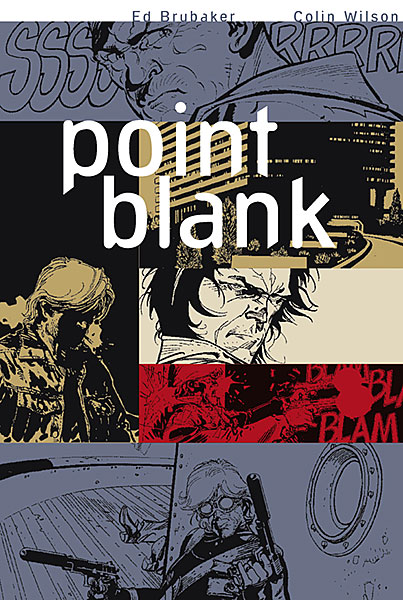 You were invited to the book fair in Frankfurt 2012 because you are from New Zealand. Is there a touch of New Zealand in your work?
You were invited to the book fair in Frankfurt 2012 because you are from New Zealand. Is there a touch of New Zealand in your work?
In my work not so much, but it’s fantastic to get that opportunity, because from the New Zealand I know, comic artists are invisible and not very appreciated by society. But obviously things are changing now. Being invited to Frankfurt is a major step for people realizing that there are artists from New Zealand working in comics and other media.
Would Maori culture or other subjects related to New Zealand be interesting stories for your comics?
For me not too much. But other artists have done that. Mine is much more a straight-forward commercial comic work and I am an artist for hire. Whereas there are creators in Australia and New Zealand who do a much more personal work. They publish their work e.g. in local newspapers and I think it’s a great step for people living there being inspired by their surroundings.
At this stage the interview took a break because Colin had to start signing. The rules: Only the first 15 in the queue receive a sketch, because Wilson is a rather slow artist. When it was my turn, I continued asking questions while he was drawing sketches.
Which one is your favorite Garth Ennis comic?
I don’t read them. They are… (thinks)
… over the top.
(smiles) Yes, that’s the right word for it.
What’s easier for you to draw, machines or people?
Machines. It’s more fun and I like planes and racing cars a lot.
Have you been to a Formula 1 race yet?
Yes. But, you know, in Melbourne the best seats are owned by the big companies.
Would you like to do a Formula 1 comic?
No.
In the Battler Britton interview you said you are fascinated by Germany. What does that mean?
You know, the fact that it is a very important country and the history of the last 100 years. In New Zealand I learned about Europe, but mainly about Britain.
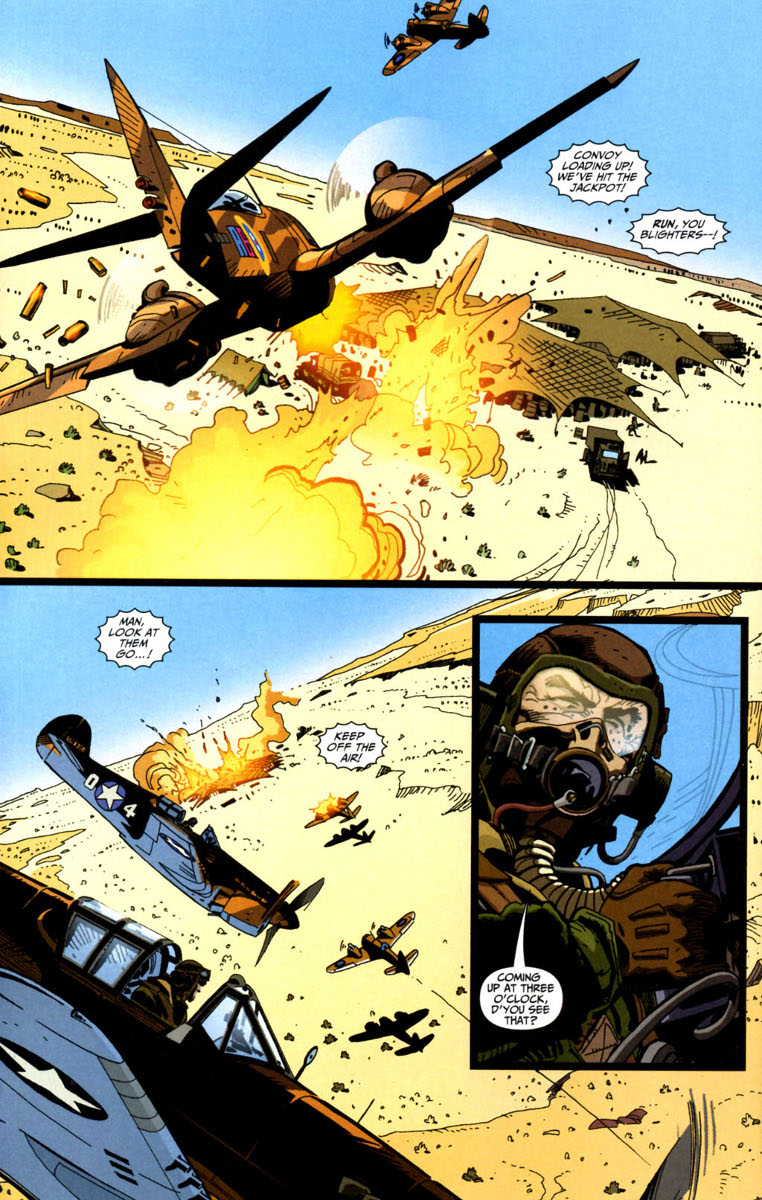 I ask him to draw a Messerschmitt Me 262 plane and show him the french comic book Ciel en ruine as a reference.
I ask him to draw a Messerschmitt Me 262 plane and show him the french comic book Ciel en ruine as a reference.
That’s the most beautiful plane to draw. I haven’t done it before. I think I know this series.
And the Stuka (an abbrevation for „Sturzkampfflugzeug“ Junkers 87) is the most difficult one to draw, like you said in the Battler interview?
Yes, it is.
I show him a photograph of the Gotha Go 229 / Horton H IX airplane.
Do you know this plane?
No. Was it a real plane?
Yes it was. It was the first stealth jet fighter. It was made out of wood to avoid radar. No metal, a one-wing plane. 50 years ahead of it’s time. A secret weapon like the Me 163 and the V2. They have one in a museum in the USA.
Really? Making a plane out of wood is very good so it doesn’t get too heavy. The Corsair was made of wood as well.
Not so good if the plane is shot at.
That’s true.
Being set in World War II, Battler Britton features a lot of swastikas. Despite certain exceptions, officially it is not allowed to use the Swastika in Germany.
Do you know about the Swastika, that it’s not allowed to use it?
I have just learned that this moment. From the history I can understand that.
In Germany coping with World War II is like walking on very thin ice. Do you care about the difference between SS, Wehrmacht and Luftwaffe or were they all just Nazis?
You know, Garth and I care a lot about historical accuracy, but comic books tend to be more black and white and generalize things, make it easier.
But the story is mainly the job of the author, in this case Garth Ennis, and you don’t have too much influence on it.
Yeah, that’s right.
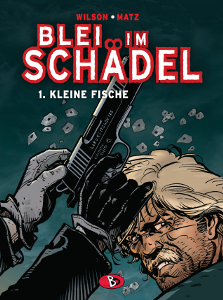 Were did you live in England?
Were did you live in England?
I lived near London. I started in a social flat.
Are the people in England different from the people in New Zealand?
When I grew up we felt very much like we were British, including the houses and so on. I always wished we would develop more of an own identity. That’s changed now.
Most people think New Zealand is a dream location and it’s as pretty as they have seen it in the Lord of the Rings movies. Is it like that?
Oh yes, it is. I know a lot of the places from the movie, even though they did some tricks for the movie.
At this point, our time was up and we continued the interview via e-mail.
Did your visit change your image of Germany a lot or have you expected it to be just like it is? Is it a lot different than the countries you have lived in?
I had a great time … I wasn’t sure exactly what I had to expect, but the two weeks I recently spent there went by so quickly that I’d like to organize a lot more time in Germany when I am next in Europe. One thing that really did surprise me is just how small Germany seems … I’m a huge history fan, and I’ve read so much about European history and the dominant part that Germany has so often had there over the last 150 years, and yet it seemed much smaller than I had expected. Impressive, and very interesting.
 Do you think comic book artists get more respect now than in the past, when they were not even allowed to sign their artwork? The French started calling comics the Ninth Art, do the English-speaking countries pay the same respect?
Do you think comic book artists get more respect now than in the past, when they were not even allowed to sign their artwork? The French started calling comics the Ninth Art, do the English-speaking countries pay the same respect?
No, I’m afraid that in English speaking countries comics remain very much invisible in mainstream media, and comic authors have a long way to go before they are treated the way they are in France. It is a cultural thing, and despite the high profile of recent US movies such as The Avengers, Iron Man or the Dark Knight trilogy, these days English language comics are still pretty much invisible to the average consumer, and are all but ignored by the mainstream media.
Which character or plane to you have to draw most often at comic book shop signings? Can it be a drag to do the same thing too often (like being The Rolling Stones and you have to perform „Satisfaction“ over and over again. Must be hard. 😉 )?
I’ve never had a problem with this, as I made the decision early on to try and not repeat the same two or three images of each character I draw while signing books at a convention or bookshop. That way it never becomes boring. Some days after several hours of drawing the same character – and I drew a LOT of Blueberries during my recent visit to Germany! – and you are tired, it can become difficult to always come up with something new. Eventually you can find yourself drawing similar poses of your most popular characters, but it is not too difficult to add one or two little touches just to keep everything fresh and interesting.
 How much freedom do you have as a Star Wars author? Do you know the movies and the rest of the franchise? Is it a good opportunity to get some kind of secure income or is it a lot of stress because you have to produce a lot of pages in a short time?
How much freedom do you have as a Star Wars author? Do you know the movies and the rest of the franchise? Is it a good opportunity to get some kind of secure income or is it a lot of stress because you have to produce a lot of pages in a short time?
I was amazed to discover that Tom (Taylor – the writer on Star Wars: Invasion) and I had almost complete freedom to do what we wanted to with our recent Star Wars series. We knew that Lucasfilms looks very closely at everything set in the Star Wars Universe, and early on I was very aware of this, but gradually I discovered that we was free to create and design a huge amount of new characters and hardware to include in the series. Obviously we were both very aware of the overall look and feel of everything SW related, and I’m sure that we would not have been given such freedom with Invasion if Dark Horse were not confident that we would respect everything that had already been published, but it was really encouraging to be allowed such freedom to work within a universe that had had such a huge influence on the both of us over the last 30 years.
My only real problem is with the amount of work that is required to produce a regular 22-page US comic series. I have never worked with an inker and so I was only prepared to do the artwork if I could do it all myself, and luckily Dark Horse were prepared to accept a large gap between each story, so that I was able to spend the time I required to produce the artwork. Obviously it is not a good idea to have too long a break between each story arc, and unfortunately the constant deadlines can still become really exhausting …
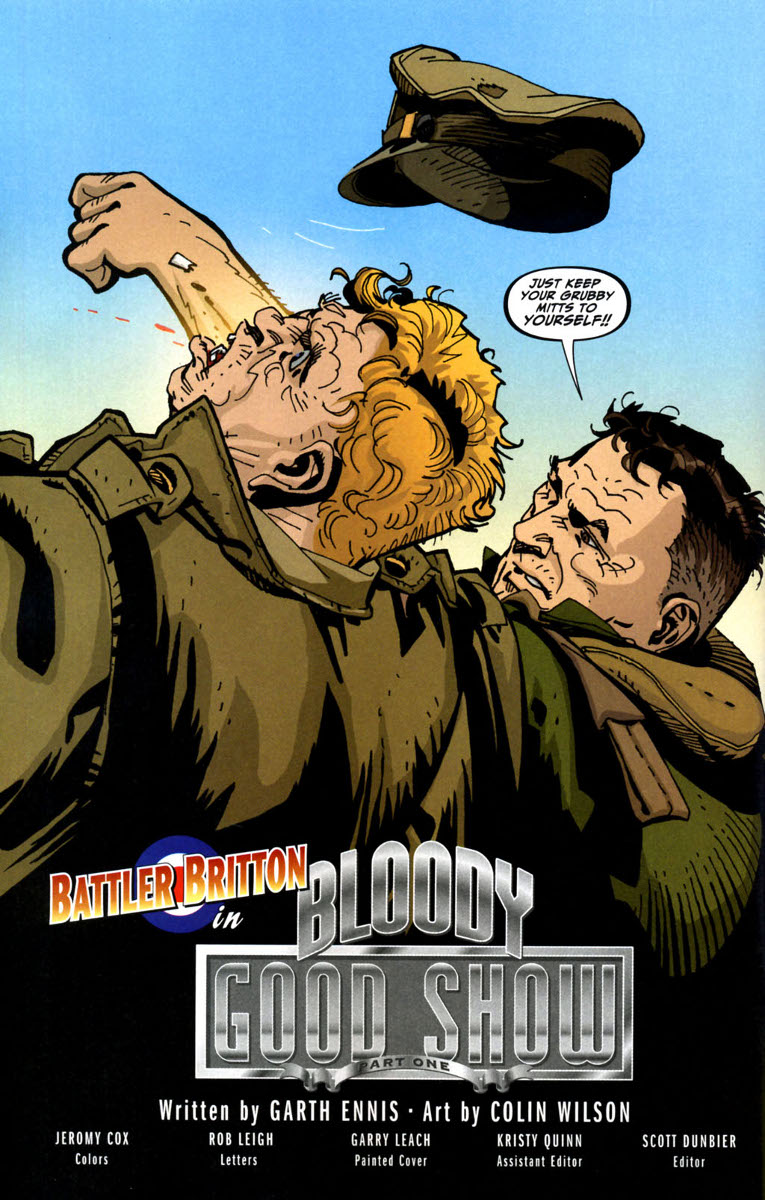 I think Battler Britton is mainly a homage to the artists of the 50s and 60s and the war is more like a game rather than actual reality. There is no political message in it at all, I think. The battles, combats and heroes of this comic serve primarily as entertainment, similar to early war movies. Would you agree?
I think Battler Britton is mainly a homage to the artists of the 50s and 60s and the war is more like a game rather than actual reality. There is no political message in it at all, I think. The battles, combats and heroes of this comic serve primarily as entertainment, similar to early war movies. Would you agree?
Perhaps there is some truth there, and with Battler Britton Garth and I certainly wanted to pay homage to the small format UK WW2 comics that we both grew up with. My usual approach is to try and make everything as realistic as possible in the art I produce for the various action series that I have worked on, and so to treat Battler a little more lightly was something I found very refreshing at the time. And of course it was also a wonderful opportunity for me to pay homage to a comic artist who had a tremendous influence on me when I was growing up – the great Ian Kennedy.
War movies have changed from A Bridge Too Far and Battle of Britain to Saving Private Ryan. Nowadays there’s more realism, pain and horror in those movies. The characters don’t act like John Wayne any more. Tony Soprano would ask: ‚What happened to the strong, silent guy, where is Gary Cooper now?‘ Garth Ennis is a huge fan of Clint Eastwood. Do you think Battler Britton would work in this modernized, post-cold-war make-over?
No, I can’t imagine Battler working that way. While those Fleetway WW2 books from the 50s and 60s were very much a product of their time, the best of the stories often involved complex character interactions and moral issues raised by war, and for me they certainly served as a wonderful introduction to what comics can be capable of doing. As with westerns, war books and movies these days really need to be more extreme and realistic, but this just means that one day someone will find a way to handle things in a new or refreshing way, or rediscover an ‚old‘ approach – e.g. the film The Artist earlier this year – and tastes will change.
Do you like what men have become, you know, the Kurt Cobain type or Justin Timberlake or Matt Damon? Or haven’t men changed at all and that’s just an image the TV wants us to believe?
I think that it is always very risky to compare reality with the current trends in modern media. The high profile figures we see in movies or rock or the media are really only a product of the era that produce them. Time moves on, fashions change, and a few of our current media „stars“ will last the transition, but will we really be admiring Lady Gaga in 10 years time?
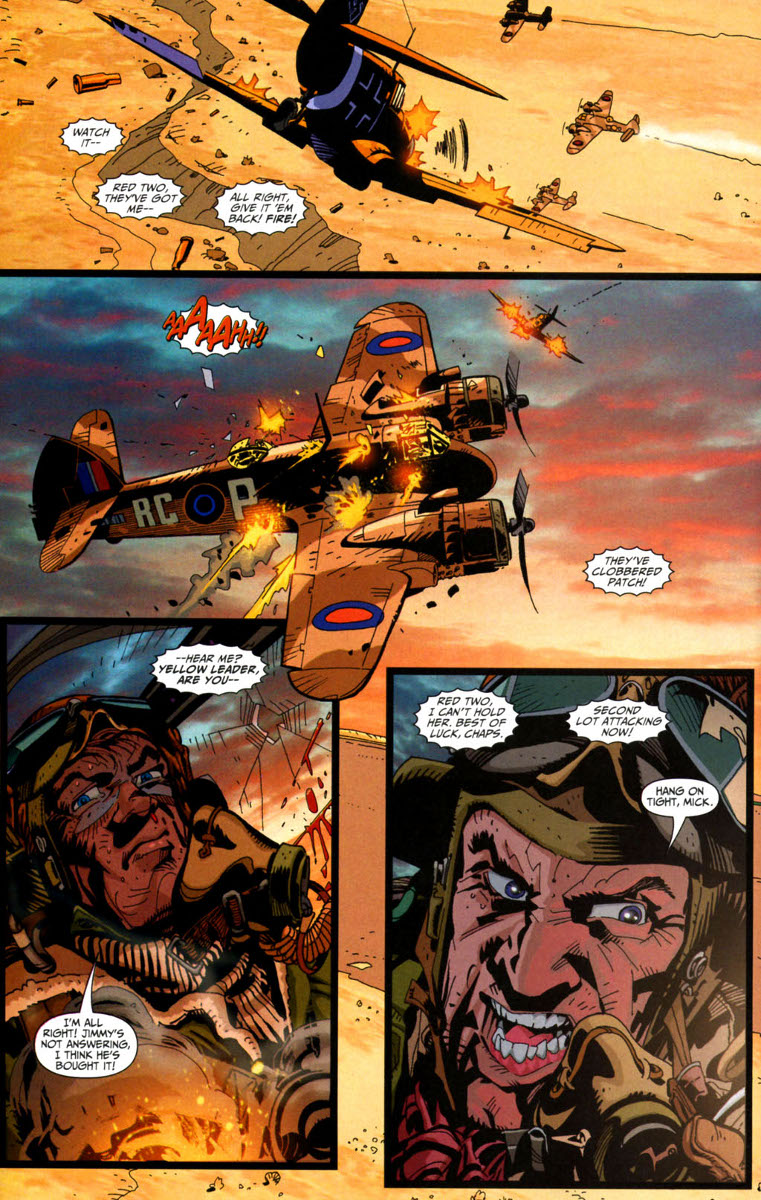 Could you decide how the Deluxe Battler (published by Panini in Germany to coincide with Wilson’s visit) would look like or is that the job of the publisher?
Could you decide how the Deluxe Battler (published by Panini in Germany to coincide with Wilson’s visit) would look like or is that the job of the publisher?
Garth and I were both asked to write new introductions for the Deluxe Battler, and I supplied the additional artwork, but Panini were responsible for putting the edition together. I may have been told, but it never registered with me that this was to be in that larger format, and so I was pleasantly surprised to see the edition when I arrived in Germany. Panini did a wonderful job!
Is it more fun to do Battler than Star Wars?
How can I favour one over the other? Both have been great to work on, and I am very proud to have had the opportunity …
Will we get more of Battler Britton or other war stories from you (and Garth)? Which are your next comics?
Both Garth and I would love to do more Battler Britton stories, but unfortunately both our schedules probably won’t allow space for this, at least in the foreseeable future. I am currently working with Frank Giroud on a XIII Mystery book for Dargaud, and following this I have a completely new series for Delcourt to start into, and so it may be a while before I can return to our favourite RAF WW2 pilot …
You also worked on Judge Dredd comics for some time. Do you still follow that character, do you know the new movie?
I had the opportunity to work at 2000 AD during a wonderful era that introduced a huge amount of talent that went on to make an impact in comics, but I think I was already working in France by the time that the next wave of names – Garth Ennis, Alan Moore, Simon Bisley etc – worked for the weekly. I moved to Paris in about 1983, and at that time Judge Dredd and 2000 AD were practically unknown in France, and so I wasn’t aware of this new influx of talent until years later.
Which are your favourite comics and artists?
This is something that always changes, as one of the riches of the medium that you are always discovering new artists and writers who are doing wonderful work that you previously had no idea even existed. Just this week, a friend showed me a terrific Tex book illustrated by the wonderful Corrado Mastantuono, who until then I had never even heard of before! A couple of months ago I stumbled onto the amazing work of Marcos Mateu-Mestre. Where do these guys come from?
Thank you very much for your time and tell the people in Australia: There’s more than Bavaria, beer and sausages in Germany. 🙂
Not that there is anything wrong with Bavaria, beer OR sausage! 🙂
But I had a terrific time, and we are already talking about doing something similar in a year or so. I’m looking forward to it!
